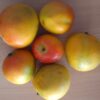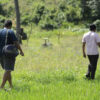My parents have always been home gardeners. For as far back as I can remember, Sundays were spent of the roof, de-weeding, re-potting or harvesting produce. It became so much of a routine that I hardly ever stopped to even think about the significance of it. It was only when I moved out of the house did I realise that I actually missed that routine.
So I decided to start gardening. It started with some marigolds and jasmines but I quickly started to experiment with potatoes. My logic was, if I can grow my own staples, there are two main benefits. I’d save a fortune on my weekly vegetable shopping and be eating chemical fertiliser and pesticide free food at the same time. As I watched my first batch sprout from the ground, I was delighted as my masterplan was finally in motion. And there was nothing to it, you put a seed in the ground and it grows, bears fruit and you reap the benefits.
As quickly as my dreams had taken shape, they all came crashing down as my entire crop got infected and died. And that’s when I realised that there might be a bit more to this than I had anticipated. I was sure about the fact that I did not want to use any chemical pesticides or fertilisers on my crops. Its funny how not-okay you are with it when you’re doing it yourself and the complacency that sets in when you pick up inorganically grown vegetables at the supermarket. I conferred with my aunt who is a plant genetics scientist who wasn’t the least bit surprised when I told her what had happened. Apparently, potatoes and not native to Bangalore, where I had been growing them, which made them extremely susceptible to diseases and infections. What had got my plants was Powdery Mildew.
For my second attempt, I decided to grow beans. I watched in proud appreciation as the stalks started to climb up the supports I had so lovingly put out for them. But just as before, they were reduced to a pile of dry stems within a couple of weeks. It was pests that had got it this time. A mixture of aphids and leaf miners had done them in, ripping through the plant before it even flowered.
These experiments with growing really gave me a new-found appreciation for the food I eat and the farmers that grow them. I couldn’t even manage to keep a couple of plants alive beyond a few weeks and they managed to grow entire fields full of the stuff.
This was when I decided to get my own mini-farm on Farmizen. I picked the crops I wanted to grow on the app which suggested what to grow based on seasonality and crop rotation cycles. I headed down to the farm to help the farmers prep the land and plant the seedlings. I watched as the generously fertilised the soil using natural fertilisers.(By this time, I had retreated to the shade of a tree because my high flying city lifestyle had apparently made me too soft for farm life. But after a quick breather I persevered.)
Over the next few weeks I followed the progress of my crops on the app and when it was time for a harvest, I headed down to the farm to help the farmers harvest my crops. They joy that you get when you return from the field with a basket full of vegetables that you know you grew is indescribable. I couldn’t wait to get home and put these vegetables to work in the many dishes that were already coming to mind.
Overall, the entire experience gave me a new-found respect for the food that I eat and the supply chain that gets it to me. I would say that this experience is not for everyone, but for those of you who have ever dabbled with gardening and want to take it a step further – this is the perfect way to take that step. Your motivation really seems to sky-rocket when you see the fruits of your labor come to life. This experience also took me back to those early days gardening with my family and is now definitely an experience I would want to pass on to my future generations.
Experience the joys of naturally grown vegetables at a Farmizen mini farm near your. Visit www.farmizen.com to know more.


Comment